Passive ETFs seem to be gaining in popularity and their market share is steadily increasing. According to data from MORNINGSTAR, they now account for an impressive 39% of assets in the investment product market. Thanks to the high transparency of these types of financial instruments, we can closely observe the inflow and outflow of capital, depending on the specific investment characteristics of the fund in question. Let us therefore analyse where investment capital is currently going and where it is fleeing from.
Table of contents:
- What are ETFs?
- Where did the money flow in 2023?
- Where is investment capital currently flowing?
- Conclusions
What are ETFs?
Exchange-traded funds (ETFs) are a type of investment fund that are listed on an exchange, just like shares. They are characterised by the fact that their investment portfolios are usually structured to replicate a market, sector or industry index. Here are some key features of ETFs:
- Listing on an exchange: ETFs are bought and sold on an exchange, meaning that their prices fluctuate throughout the day depending on supply and demand.
- Index mapping: Most ETFs are designed to closely track a specific index, such as the S&P 500 or the FTSE 100. This means that their investment portfolios seek to mirror the structure of the index in question.
- Diversification: by investing in an ETF, an investor gains access to a diversified portfolio that includes a range of different assets. As a result, the risk of loss in the value of the investment can be dispersed.
- Low costs: Compared to some traditional mutual funds, ETFs often have lower management costs. This is partly due to their passive investment strategy, based on mapping an index.
The recent introduction of bitcoin spot ETFs represents the first-ever acceptance of such financial instruments for cryptocurrencies in the United States. Currently, the assets of these funds reach approximately USD 30 billion, representing 1.8% of the total value of the cryptocurrency market. The expectation of these instruments could be one of the main factors driving the growth of cryptocurrencies in late 2023.
Where did the money flow in 2023?
To discuss net flows, we need to briefly understand that it is not the same as asset appreciation. Asset flow data are intended to show changes in investor preferences in the context of a transition between distinctly different investment strategies. For many ETFs, however, there are no continuous adjustments to the amount of invested funds. Therefore, such funds will manage the same capital, the value of which is affected by changes in the market.
The largest inflow of new investment funds, amounting to approximately USD 300 billion, was seen in US equity ETFs throughout 2023, followed by fixed income bond ETFs, with inflows of approximately USD 170 billion. The third place on the podium is occupied by the broad international equity market, with inflows of around USD 80 billion. The only asset type that recorded an outflow of total invested capital is commodity-based funds.
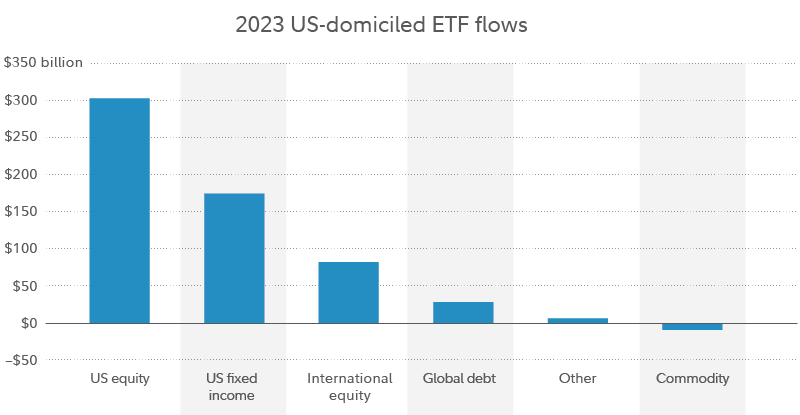
Source: Fidelity
What may seem interesting is that in the last quarter of 2023, we saw the largest amount of invested capital in the equity market. The largest inflow of funds was in the Vanguard S&P 500 ETF (VOO), which received as much as US$46.3 billion. Inflows from ETFs appear to have been one of the key sources of the index as a whole increasing in value by more than 20% in 2023.
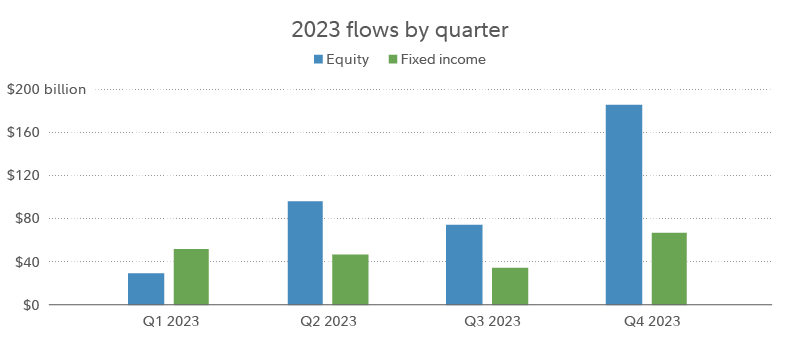
Source: Fidelity
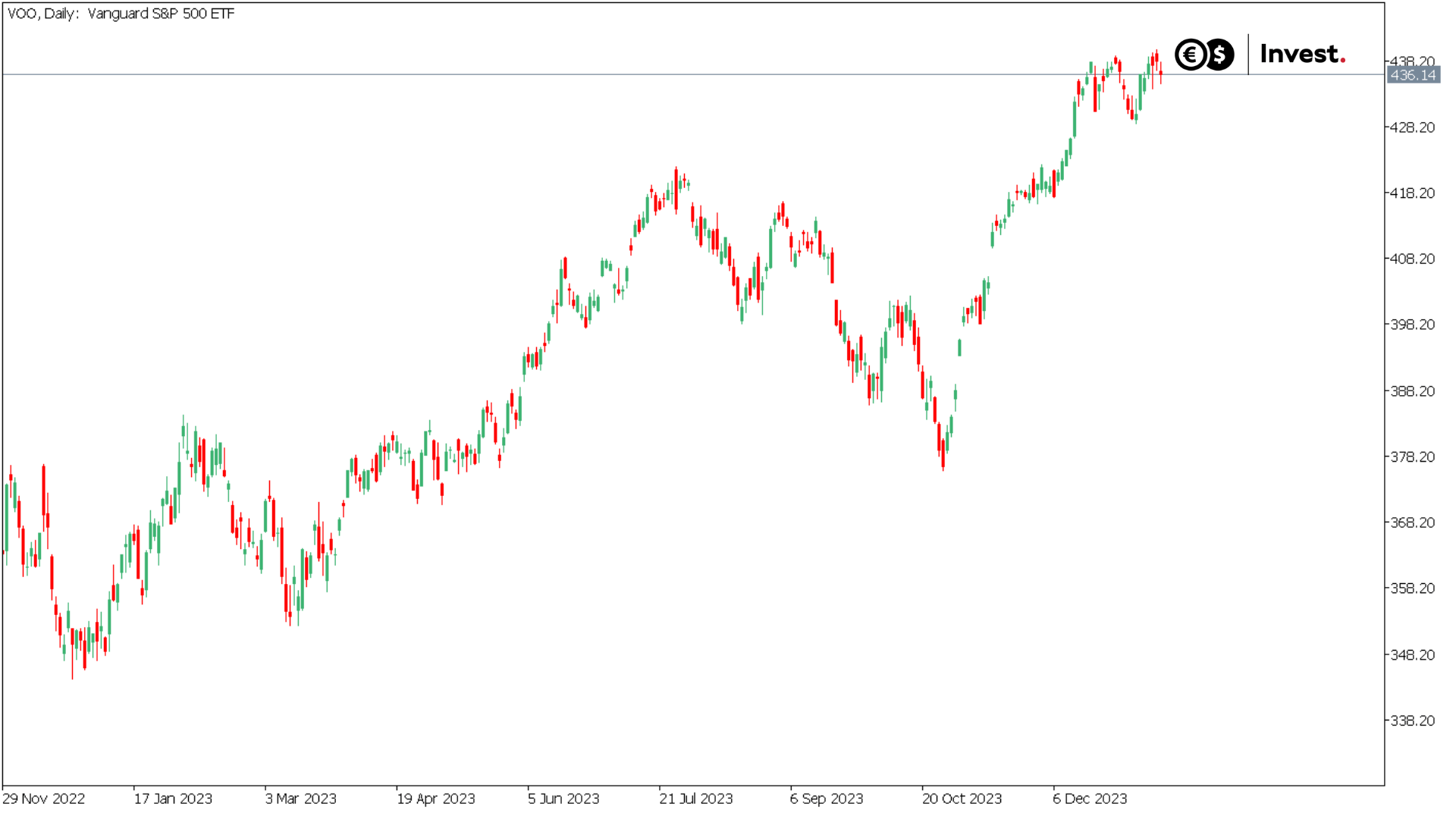
Source: Conotoxia MT5, VOO, Daily
In bonds, the iShares 20 Plus Year Treasury Bond ETF (TLT) enjoyed the largest inflow of new money, with $21bn in 2023. This ETF gives investors the opportunity to invest in long-term US Treasury bonds, whose biggest driver of growth, or decline, is changes in US interest rates. It seems that the market is increasingly pricing in the first interest rate cuts by the Fed, which would likely lead to increases on the price of this fund. Nevertheless, over the past 2 weeks we have seen temporary capital outflows from this fund.
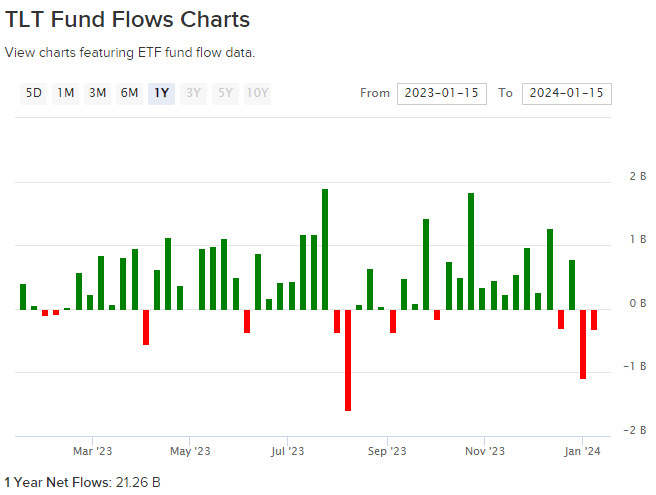
Source: VettaFi
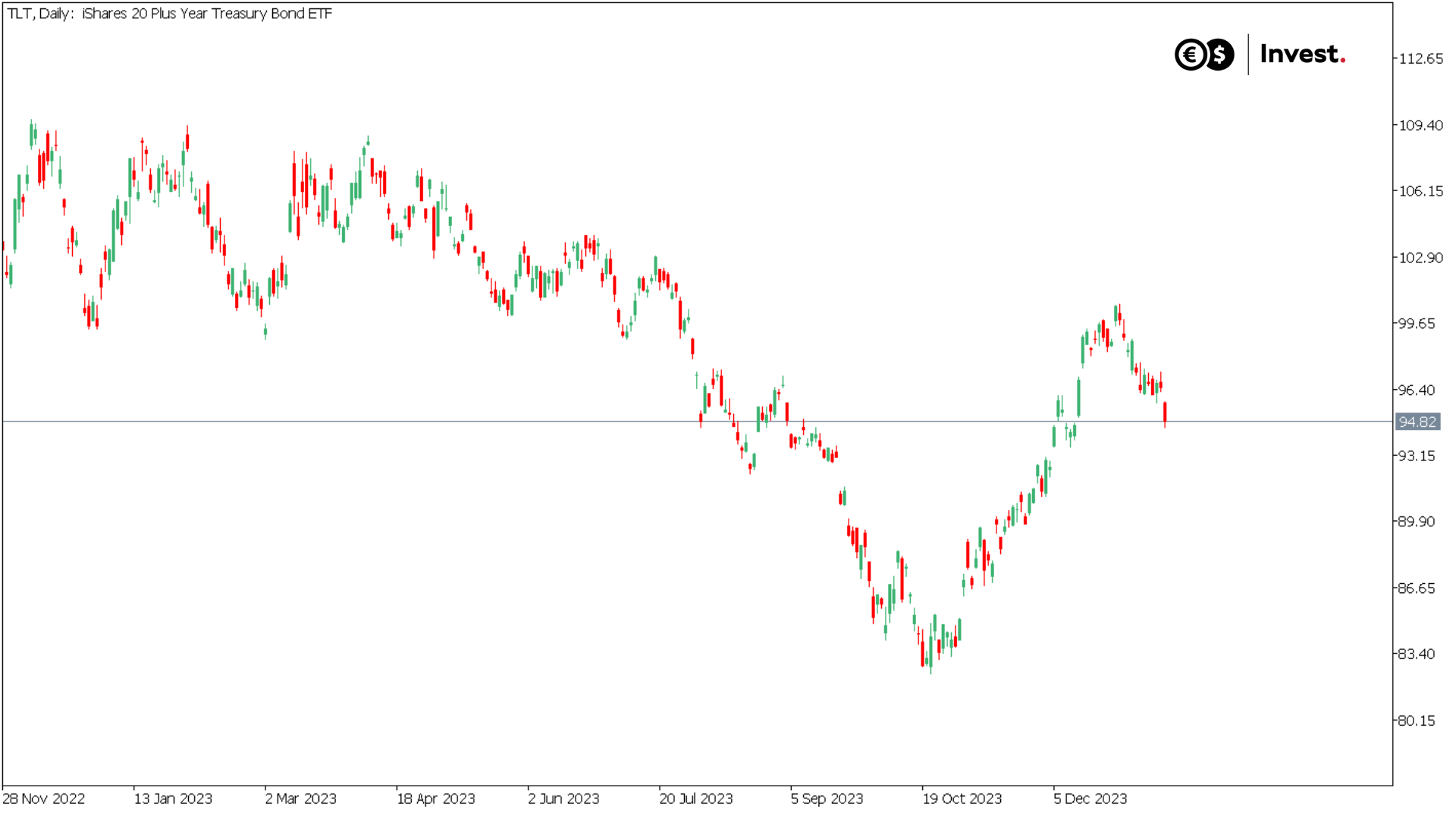
Source: Conotoxia MT5, TLT, Daily
Where is investment capital currently flowing?
Undoubtedly, the industry that has attracted the most capital over the past three months is the technology sector, mainly thanks to advances in artificial intelligence, with as much as US$7.6 billion of new money flowing in. Rarely, in second place is the US real estate sector, with an inflow of USD 2.2 billion. It seems that, as with the increase in bond inflows, the market is starting to factor in the expected drop in interest rates in the near future. In contrast, we note the largest capital outflow in the retail sector (down US$2.8 billion).
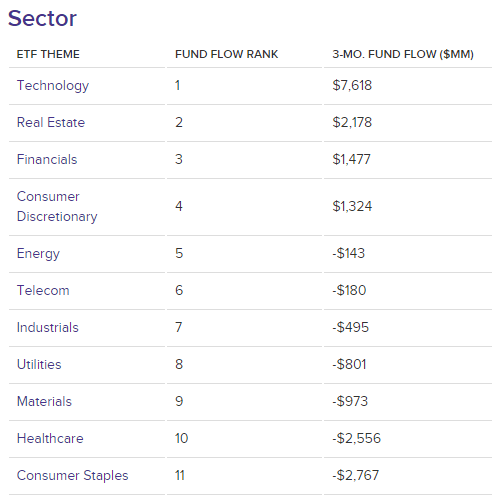
Source: VettaFi
The fund of choice for investors, with the largest amount of artificial intelligence technology-related money flowing into it, is the Invesco QQQ Trust Series 1 (QQQ). It provides investors with exposure to the Nasdaq 100 index. So it seems that in the context of a continued bull market in artificial intelligence, this index in particular is likely to gain, becoming one of investors' first choices, as we have seen in the last three weeks with new money flowing into the fund.
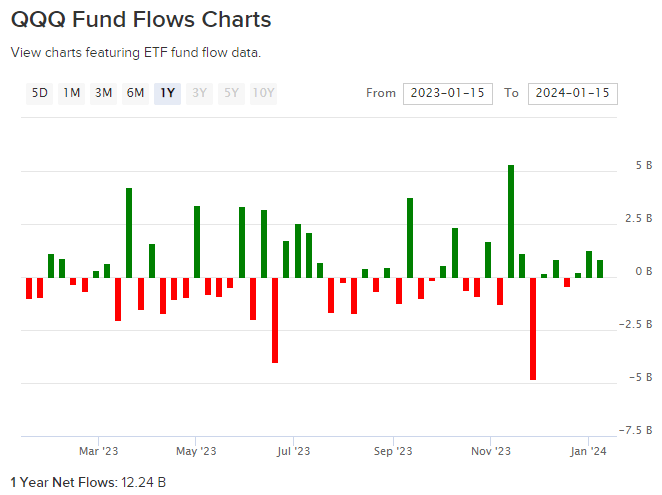
Source: VettaFi
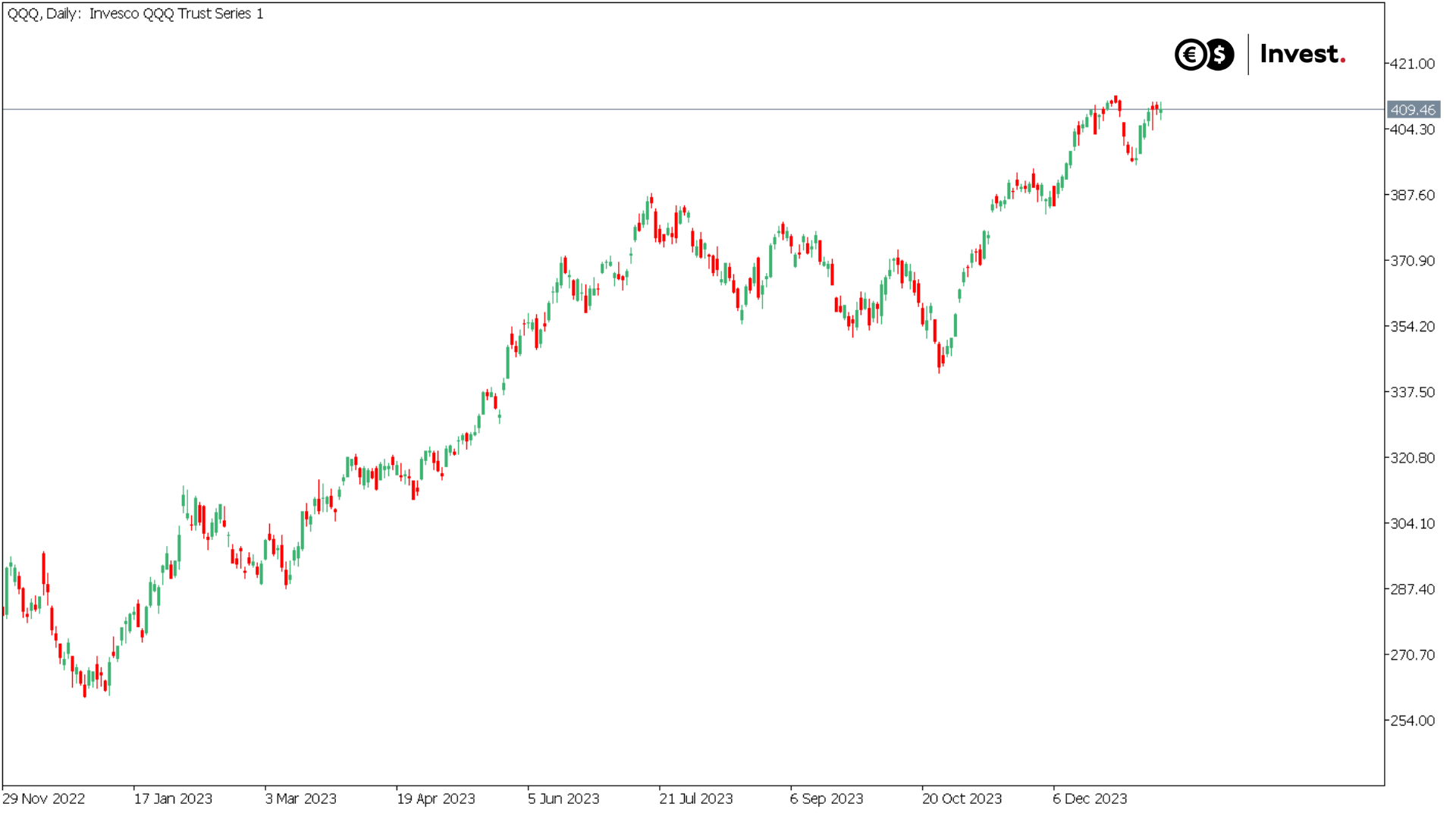
Source: Conotoxia MT5, QQQ, Daily
Analysing the latest capital flows between regions, we note that virtually the entire world is turning its attention to the United States, which received USD 151 billion in new funds. In second place, but with an incomparable value, is the emerging markets ETF region (inflow of USD 6.3 billion), followed by developed markets ETFs (inflow of USD 6 billion). However, despite the positive trend in the global equity market, we see an outflow of US$1.8bn from funds into developed European markets.
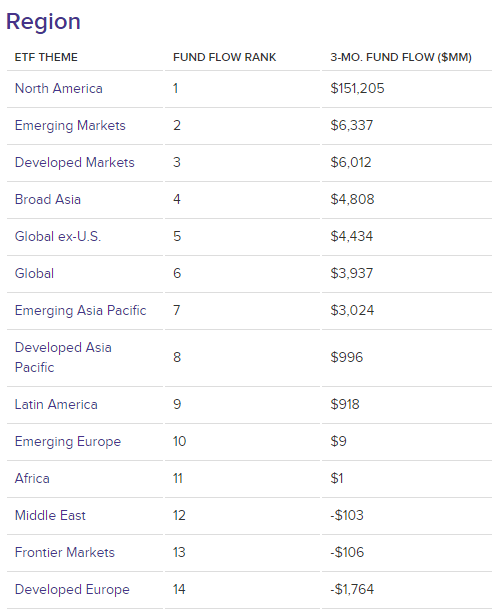
Source: VettaFi
Conclusions
In 2023, investors were most keen to invest in the US equity market, of which ETFs saw the largest inflows of new money. In the last quarter of last year, the Vanguard S&P 500 ETF (VOO) received the most capital inflows, becoming one of the key drivers of the S&P 500 index's rise of more than 20% in 2023.
The second asset was US bond ETFs. The iShares 20 Plus Year Treasury Bond ETF (TLT) gained the most new money in 2023, but we have seen temporary capital outflows from this fund in the last two weeks.
On the equity exchanges, the technology sector has attracted the most capital in the last three months, mainly thanks to advances in artificial intelligence. US real estate came second, while the retail sector saw the largest capital outflows. All these flows seem to be pricing in an increasingly strong first decision on interest rate cuts in the US.
Globally, investors turned their attention practically only to the United States. ETFs on emerging markets were the second most popular, while ETFs on developed European markets were practically the only ones to record capital outflows in recent months, which may be related to the growing unrest in the state of the economies there.
Grzegorz Dróżdż, CAI MPW, Market Analyst of Conotoxia Ltd. (Conotoxia investment service)
Materials, analysis and opinions contained, referenced or provided herein are intended solely for informational and educational purposes. Personal opinion of the author does not represent and should not be constructed as a statement or an investment advice made by Conotoxia Ltd. All indiscriminate reliance on illustrative or informational materials may lead to losses. Past performance is not a reliable indicator of future results.
CFDs are complex instruments and come with a high risk of losing money rapidly due to leverage. 71.98% of retail investor accounts lose money when trading CFDs with this provider. You should consider whether you understand how CFDs work and whether you can afford to take the high risk of losing your money.


